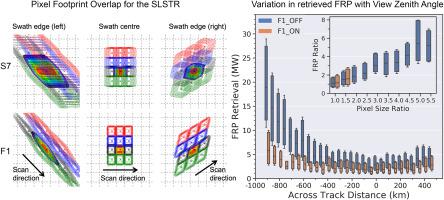Remote Sensing of Environment ( IF 11.1 ) Pub Date : 2021-05-04 , DOI: 10.1016/j.rse.2021.112460 Weidong Xu , Martin J. Wooster , Edward Polehampton , Rose Yemelyanova , Tianran Zhang

|
The Sentinel-3 satellites each carry the dual-Earth view Sea and Land Surface Temperature Radiometer (SLSTR). SLSTR data from the ‘near nadir’ scan are used to produce a set of global, daily active fire (AF) products similar to those produced from MODIS data. The Sentinel-3 AF products are generated in both Near Real Time (NRT) and Non Time Critical (NTC) mode and are expected ultimately to replace those from MODIS Terra when that mission starts to reach its end of life. Middle infrared (MIR) observations are critical for the AF application, and SLSTR has two MIR channels (S7 and F1) based on different detector designs and located at different positions in the instrument focal plane, delivering different dynamic ranges with the same spectral response function. The SLSTR AF detection and FRP retrieval algorithm uses both S7 and F1 channel data, but there are options on how these are combined to generate the final AF products. Past work has shown that MODIS' AF product characteristics are strongly view zenith angle (VZA) dependent, and since the SLSTR ‘near nadir’ scan actually extends out to a maximum VZA of 55° (similar to the maximum MODIS VZA), any such view angle dependency may also impact the choice of how the S7 and F1 channel data are combined to generate the SLSTR AF products. Here we use a combination of simulation modelling and analysis of more than 15,000 early SLSTR AF products to study how VZA affects the Sentinel-3 AF product characteristics, and how this varies when the S7 and F1 channel data are combined in different ways. Maximum use of S7 channel data provides an AF product whose statistical characteristics vary markedly with VZA around the near nadir scan. For example, the median FRP extracted from the more than 15,000 products studied varies by around an order of magnitude between the centre and edge of scan positions, a level of VZA-dependency similar to that seen with the MODIS AF products. By contrast, maximum use of data from the F1 channel provides a median FRP that varies only by a factor of ~3 over the same VZA range. Our simulation modelling demonstrates that this difference is a result of the area of the F1 channel ground pixel footprint remaining far more consistent around the near nadir scan compared to that of S7, which also leads to minimised F1 pixel oversampling even at high VZA observations. The result is that FRP retrievals for a fire derived using the F1 channel observations are far less sensitive to where in the scan the fire is observed. When generated in this way, the Sentinel-3 FRP product characteristics appear similar to those of the VIIRS AF products, since VIIRS also has a method of minimising pixel area growth away from nadir. We conclude that maximum use of the SLSTR F1 channel observations provides significant benefits to the Sentinel-3 AF product, and that unless there are other reasons not to do so any operational processing to generate the NRT and NTC product versions should consider this option as the default. Our findings also show the value of the novel detector design of the SLSTR F1 channel, whose advantageous pixel footprint characteristics mean that similar designs should be considered for future sensors aiming to support active fire applications.
中文翻译:

Sentinel-3主动式火灾探测和FRP产品性能-扫描角度和SLSTR中红外通道选择的影响
每个Sentinel-3卫星都带有双地球视图的海陆表面温度辐射计(SLSTR)。来自“近最低点”扫描的SLSTR数据用于生成一组类似于从MODIS数据生成的全球日活跃火(AF)产品。Sentinel-3 AF产品以近实时(NRT)和非关键时间(NTC)模式生成,并且有望在该任务开始寿终正寝时最终取代MODIS Terra的产品。中红外(MIR)观测对于自动对焦应用至关重要,SLSTR具有两个基于不同检测器设计的MIR通道(S7和F1),并且位于仪器焦平面的不同位置,以相同的光谱响应功能提供了不同的动态范围。SLSTR AF检测和FRP检索算法同时使用S7和F1通道数据,但是对于如何将它们组合以生成最终的AF产品,存在一些选择。过去的工作表明,MODIS的AF产品特性与视天顶角(VZA)密切相关,并且由于SLSTR“近天底”扫描实际上延伸到55°的最大VZA(类似于最大的MODIS VZA),因此视角依赖性还可能影响如何组合S7和F1通道数据以生成SLSTR AF产品的选择。在这里,我们结合仿真建模和对15,000多种早期SLSTR AF产品的分析,来研究VZA如何影响Sentinel-3 AF产品的特性,以及当以不同方式组合S7和F1通道数据时,这如何变化。最大限度地利用S7通道数据可提供AF产品,其统计特性随近天底扫描周围的VZA明显不同。例如,从研究的15,000多种产品中提取的FRP中值在扫描位置的中心和边缘之间大约相差一个数量级,其VZA依赖性水平与MODIS AF产品类似。相比之下,来自F1通道的数据的最大使用量提供的中值FRP在相同的VZA范围内仅变化约3倍。我们的仿真模型表明,这种差异是由于F1通道接地像素足迹的面积与S7相比在近天底扫描附近保持了更加一致的结果,即使在高VZA观察下,F1像素的过采样也得以最小化。结果是,使用F1通道观测结果得出的火灾的FRP检索对在扫描中观察到火灾的位置的敏感度要低得多。当以这种方式生成时,Sentinel-3 FRP产品的特性与VIIRS AF产品的特性相似,因为VIIRS还具有使像素面积增长从最低点最小化的方法。我们得出的结论是,最大程度地利用SLSTR F1通道观测值可为Sentinel-3 AF产品带来显着好处,并且除非有其他理由不这样做,否则任何用于生成NRT和NTC产品版本的操作处理都应将此选项视为该选项。默认。我们的发现还显示了SLSTR F1通道新颖的探测器设计的价值,其有利的像素足迹特性意味着对于旨在支持主动火灾应用的未来传感器,应考虑采用类似的设计。因为VIIRS还提供了一种使像素区域远离天底最小化的方法。我们得出的结论是,最大程度地利用SLSTR F1通道观测值可为Sentinel-3 AF产品带来显着好处,并且除非有其他理由不这样做,否则任何用于生成NRT和NTC产品版本的操作处理都应将此选项视为该选项。默认。我们的发现还显示了SLSTR F1通道新颖的探测器设计的价值,其有利的像素足迹特性意味着对于旨在支持主动火灾应用的未来传感器,应考虑采用类似的设计。因为VIIRS还提供了一种使像素区域远离天底最小化的方法。我们得出的结论是,最大程度地利用SLSTR F1通道观测值可为Sentinel-3 AF产品带来显着好处,并且除非有其他理由不这样做,否则任何用于生成NRT和NTC产品版本的操作处理都应将此选项视为该选项。默认。我们的发现还显示了SLSTR F1通道新颖的探测器设计的价值,其有利的像素足迹特性意味着对于旨在支持主动火灾应用的未来传感器,应考虑采用类似的设计。并且除非有其他原因不这样做,否则任何用于生成NRT和NTC产品版本的操作处理都应将此选项视为默认选项。我们的发现还显示了SLSTR F1通道新颖的探测器设计的价值,其有利的像素足迹特性意味着对于旨在支持主动火灾应用的未来传感器,应考虑采用类似的设计。并且除非有其他原因不这样做,否则任何用于生成NRT和NTC产品版本的操作处理都应将此选项视为默认选项。我们的发现还显示了SLSTR F1通道新颖的探测器设计的价值,其有利的像素足迹特性意味着对于旨在支持主动火灾应用的未来传感器,应考虑采用类似的设计。











































 京公网安备 11010802027423号
京公网安备 11010802027423号